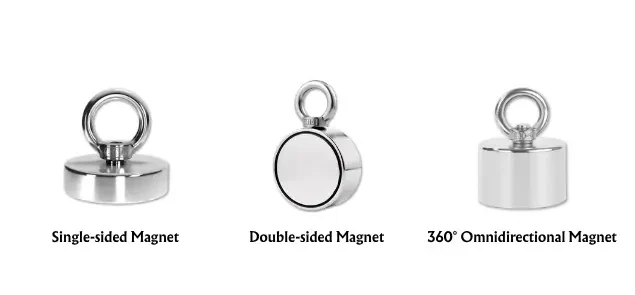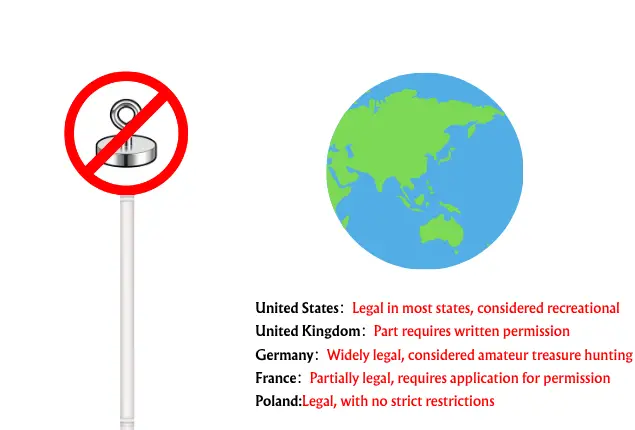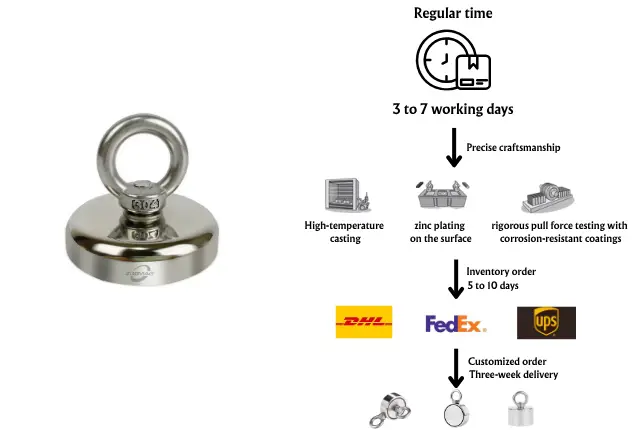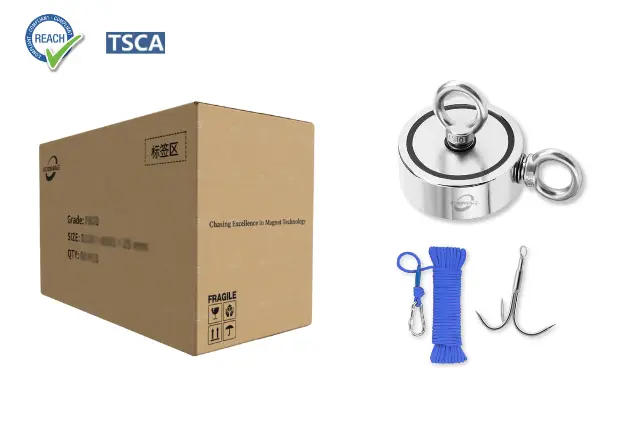Ultimate Fishing Magnet Guide
The Origin of Fishing Magnet
Fishing magnet originated from the ancient canals of Europe, where people used powerful magnets to attract metal debris from the bottom of the water to alleviate canal siltation and pollution. Although this activity is called “fishing,” it doesn’t actually involve real fishing. instead, it simulates the actions of casting and reeling in a rod. The greatest fun lies in not knowing what you’ll catch, iron cans are the most common. but if you’re lucky, you might even reel in hidden treasures from the riverbed. Today, this adventurous outdoor activity has swept across the globe.

What is Fishing Magnet?

Fishing magnet isn’t for catching fish. it’s an exploration activity that uses powerful magnets in rivers, lakes, canals, and other bodies of water to salvage items. By attracting and retrieving metal objects from the water, people experience the dual joys of cleaning the waterway and discovering treasures. This type of magnet is also known as a recovery magnet, search magnet, or salvage magnet.
Compared to similar products like metal detectors and professional salvage tools, the biggest advantage of fishing magnet is its extremely low entry barrier, a basic set of gear often costs just a few hundred yuan, making it easy for more people to participate.
Fishing Magnet Specifications
1. Diameter

For ease of operation and safety considerations, we recommend that beginners avoid starting with overly large sizes. For those just getting started, trying a salvage round magnet with a diameter of 60-100 mm is more appropriate.
If you’re unsure about the right size for a specific salvage target or body of water, feel free to message us at any time, we’ll provide personalized recommendations to help you salvage efficiently and effortlessly.
2. Pull Force

3. Types

Single-sided Magnet: Only one side is magnetized, with the magnetic field concentrated vertically, suitable for precise vertical salvage on flat riverbeds.
Double-sided Magnet: Two circular neodymium magnets are symmetrically encased on both sides of a metal shell, allowing adsorption on either face, effectively improving retrieval efficiency.
360° Omnidirectional Magnet: Features a ring-shaped neodymium magnet with a magnetic field covering the entire outer shell, enabling adsorption from any angle. Due to its complex manufacturing process and larger magnet size, it is generally more expensive than the first two types.
| Magnet Type | Core Advantage | Best Application Scenario |
|---|---|---|
| Single-sided Magnet | Highly concentrated vertical magnetic force | Simple flat waters |
| Double-sided Magnet | Dual-sided adsorption | Medium complex waters |
| 360° Omnidirectional Magnet | All-around adsorption with no blind spots | Extreme complex waters |
As a professional neodymium magnet factory, we offer a vast array of customization options for fishing magnet tools. Send us an inquiry right away, and our team will respond within 24 hours, providing free sample testing and optimization suggestions to create your exclusive “underwater hunter” together
Fishing Magnet Accessories

| Accessories | Core Function | Recommended Brands |
|---|---|---|
| Strong Magnet | Core tool for adsorbing underwater metal objects | TOPMAG |
| Synthetic Rope | Device for connecting magnet throwing and recovery | Yates, Teufelberger, Edelweiss |
| Carabiner | Quick link device | Edelrid, Petzl, Black Diamond |
| Cut-resistant Gloves | Prevent metal cuts | SHOWA, Mechanix, Ansell |
| Life Jacket | Provides immediate buoyancy rescue | Viking, Crewsaver, Spinlock |
| Non-slip Shoes | Traction boots to prevent falls in wet environments | KEEN, Salomon, La Sportiva |
Best Knot-Tying Techniques for Fishing Magnet

Improved Clinch Knot
Connects the line to the magnet’s eyelet, suitable for thinner nylon ropes. Ideal for lightweight to small magnets (100-200 kg pull force).
Tying Steps:
- Thread the nylon rope through the magnet’s eyelet, leaving about 15 cm of tag end.
- Wrap the tag end around the main line 5-7 times, from the eyelet outward, keeping wraps even and non-overlapping.
- Pass the tag end through the small loop between the eyelet and the main line.
- Then pass the tag end through the newly formed second small loop.
- Wet the rope and slowly tighten the main line and tag end, ensuring the wraps are neat.
- Check if the knot is secure, trim excess tag end, leaving 1-2 mm.
Palomar Knot
Generally used to connect the nylon rope end of a magnetic rope to the magnet’s eyelet or bolt, suitable for looping a single rope around the eyelet. Ideal for medium magnets (100-300 kg pull force).
Tying Steps:
- Take a section of nylon rope and fold it to form a loop, leaving about 15-20 cm working end.
- Pass the loop through the magnet’s eyelet or bolt hole.
- With the loop, tie a loose single overhand knot around the main line (loop crosses over itself and passes through its own loop, keeping it loose).
- Fully pass the magnet’s eyelet through the loop, ensuring the magnet goes through the entire ring.
- Wet the rope and slowly tighten the main line and tag end with both hands, ensuring the knot is smooth and flush against the eyelet.
- Check if the knot is secure, trim excess tag end, leaving 1-2 mm.
Figure-Eight Knot
Primarily used as a stopper knot, but also for connecting the line to the magnet’s eyelet in sturdy situations. Ideal for heavy-duty magnets (300-1000 kg pull force).
Tying Steps:
- Thread the nylon rope through the magnet’s eyelet, leaving about 20 cm working end.
- Tie a single loop on the main line.
- Pass the tag end under the single loop from below, forming a “8” shape.
- Pass the tag end back through the magnet’s eyelet or around the main line again, as needed for securing.
- Wet the rope and slowly tighten the main line and tag end, ensuring the “8” shape is clear and symmetrical.
- Check if the knot is secure, trim excess tag end, leaving 1-2 mm.
| Knot Type | Suitable Magnet | Core Advantage |
|---|---|---|
| Improved Clinch Knot | 100-200 kg Lightweight | Excellent slip resistance, specialized for thin ropes |
| Palomar Knot | 100-300 kg Medium | Easy to tie, balanced pull resistance |
| Figure-Eight Knot | 100-200 kg Heavy-Duty | Ultra-high strength, impact resistant |
How to cast and retrieve your fishing magnets?

Site Selection and Preparation: Choose a flat, open waterside spot, under bridges, docks, or old industrial areas are priorities, as they have more metal deposits. Check that the rope and magnet connection is secure, relax the rope into large coils, and leave 3-5 meters of rope for easy operation without tangling.
Casting Action: For the water surface you want to target, lean slightly forward with feet firmly planted. Hold the magnet in one hand and the rope in the other. Cast the line like swinging a fishing rod, aiming for 10-15 meters on the water surface. After casting, don’t rush to reel in—let the magnet sink with the current, keeping the line’s tension controllable.
Bottom Settling and Initial Dragging: Once the magnet hits the bottom (about 10-30 seconds), grip the rope with both hands and slowly pull back, applying even force to feel the resistance. Let the magnet slide gradually to attract metal objects on the bottom. If resistance is very strong, pause and adjust the angle to avoid getting stuck.
Retrieval and Shore Landing: Once something is attached, reel the rope up to the surface and use a net to scoop it up, avoiding direct hand contact with sharp objects.
Is Fishing Magnet Illegal?

| Country/Region | Legality Overview | Basic Requirements and Restrictions |
|---|---|---|
| United States | Legal in most states, considered recreational | Generally operable in public waters without a permit. Prohibited in historical sites, nature reserves, or military areas. Report found artifacts immediately |
| United Kingdom | Legal | Must obtain written permission from landowners for private waters. Generally open in public rivers |
| Germany | Widely legal, considered amateur treasure hunting | Follow local waterway access rules. Generally open in public rivers, but permits required in Hamburg |
| France | Partially legal | Apply for permission from the local cultural department |
| Poland | Legal, with no strict restrictions | Generally open in public lakes and rivers, but environmental permits needed in sensitive areas like the Vistula River |
Fishing Magnet Delivery Timeline

The production process for fishing magnet tools emphasizes precision craftsmanship, including high-temperature casting of neodymium magnets, zinc plating on the surface, and rigorous pull force testing with corrosion-resistant coatings, these steps ensure high strength and long-lasting performance. For in-stock orders, we expect to ship within about 3 days of placing the order via international couriers like DHL, FedEx, or UPS, with delivery to your destination taking 5-10 days and full tracking provided. For in-stock fishing magnet tools, contact us for detailed information.
Custom orders, require additional production time, we default to shipping three weeks after ordering, depending on complexity, to perfectly match your needs.
Fishing Magnet Packaging Design

Warm Tip: The above is our standard packaging scheme, specific details will align with your order. We’ll reconfirm details upon order placement to ensure the packaging and product perfectly match your needs.
Frequently Asked Questions (FAQ)
- Single-Sided Fishing Magnet or Double-Sided? Single-sided is suitable for precise salvage in flat riverbeds, while double-sided offers higher retrieval efficiency and is better for salvaging cluttered underwater items.
- How to Maintain the Rope? After use, rinse it thoroughly with clean water and air-dry in a cool, shaded place. Avoid direct sunlight and contact with chemicals to prevent corrosion.
- Will Fishing Magnet Tools Rust? Neodymium magnets are prone to rust, but ours are zinc-plated for basic rust protection lasting 1-2 years.
- Is It Suitable for Children? Absolutely not! This activity is strictly prohibited for children to do alone. we strongly advise parents not to let children handle fishing magnet tools.
